sensor INFINITI QX56 2009 Factory Workshop Manual
[x] Cancel search | Manufacturer: INFINITI, Model Year: 2009, Model line: QX56, Model: INFINITI QX56 2009Pages: 4171, PDF Size: 84.65 MB
Page 141 of 4171
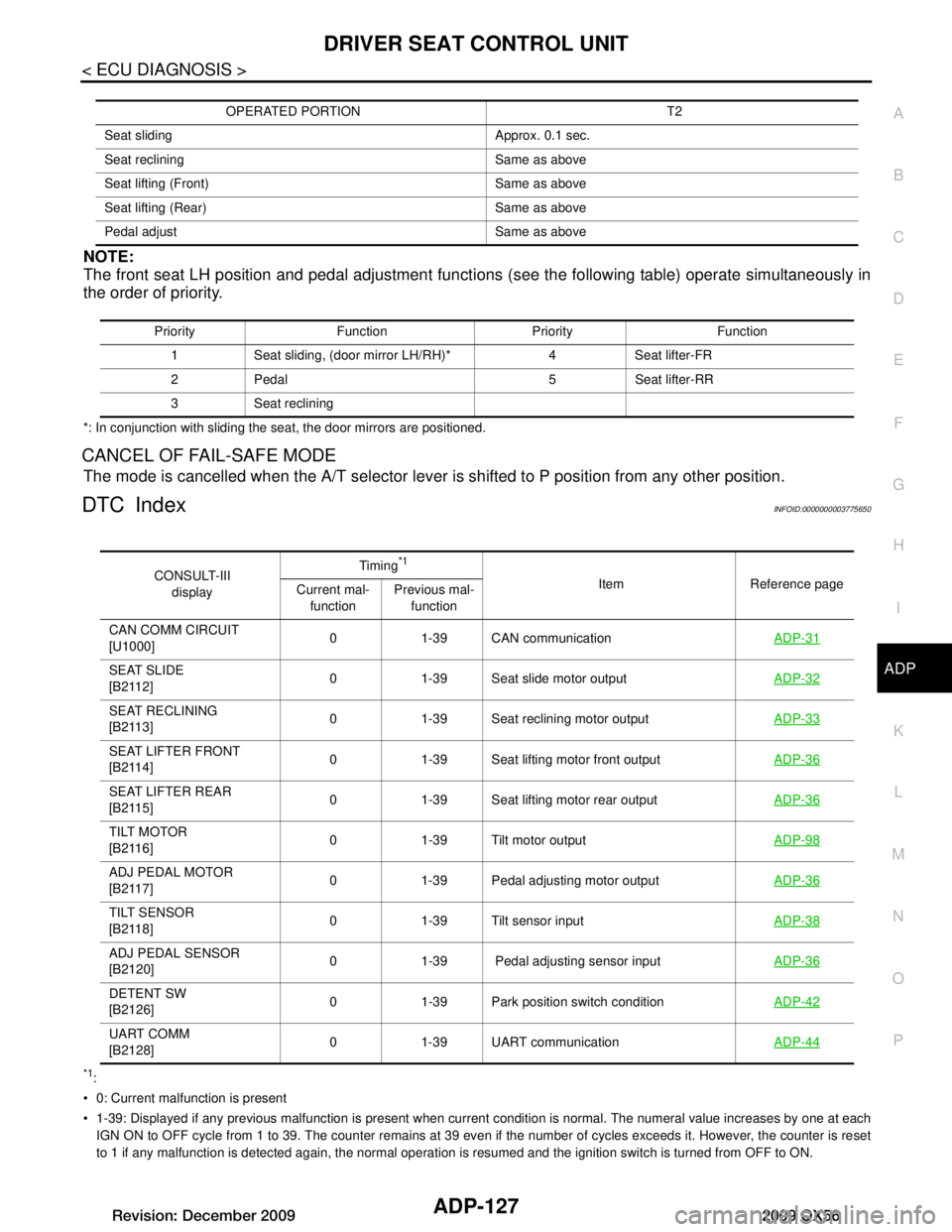
DRIVER SEAT CONTROL UNITADP-127
< ECU DIAGNOSIS >
C
DE
F
G H
I
K L
M A
B
ADP
N
O P
NOTE:
The front seat LH position and pedal adjustment functi ons (see the following table) operate simultaneously in
the order of priority.
*: In conjunction with sliding the seat, the door mirrors are positioned.
CANCEL OF FAIL-SAFE MODE
The mode is cancelled when the A/T selector lever is shifted to P position from any other position.
DTC IndexINFOID:0000000003775650
*1:
0: Current malfunction is present
1-39: Displayed if any previous malfunction is present when current condition is normal. The numeral value increases by one at each
IGN ON to OFF cycle from 1 to 39. The counter remains at 39 even if the number of cycles exceeds it. However, the counter is re set
to 1 if any malfunction is detected again, the normal operation is resumed and the ignition switch is turned from OFF to ON. OPERATED PORTION T2
Seat sliding Approx. 0.1 sec.
Seat reclining Same as above
Seat lifting (Front) Same as above
Seat lifting (Rear) Same as above
Pedal adjust Same as above
Priority Function Priority Function1 Seat sliding, (door mirro r LH/RH)* 4 Seat lifter-FR
2 Pedal 5 Seat lifter-RR
3Seat reclining
CONSULT-III display Timing
*1
Item Reference page
Current mal-
function Previous mal-
function
CAN COMM CIRCUIT
[U1000] 0 1-39 CAN communication
ADP-31
SEAT SLIDE
[B2112]0 1-39 Seat slide motor output
ADP-32
SEAT RECLINING
[B2113]0 1-39 Seat reclining motor output
ADP-33
SEAT LIFTER FRONT
[B2114]0 1-39 Seat lifting motor front output
ADP-36
SEAT LIFTER REAR
[B2115]0 1-39 Seat lifting motor rear output
ADP-36
TILT MOTOR
[B2116]0 1-39 Tilt motor output
ADP-98
ADJ PEDAL MOTOR
[B2117]0 1-39 Pedal adjusting motor output
ADP-36
TILT SENSOR
[B2118]0 1-39 Tilt sensor input
ADP-38
ADJ PEDAL SENSOR
[B2120]0 1-39 Pedal adjusting sensor input
ADP-36
DETENT SW
[B2126]0 1-39 Park position switch condition
ADP-42
UART COMM
[B2128]0 1-39 UART communication
ADP-44
Revision: December 20092009 QX56
Page 142 of 4171
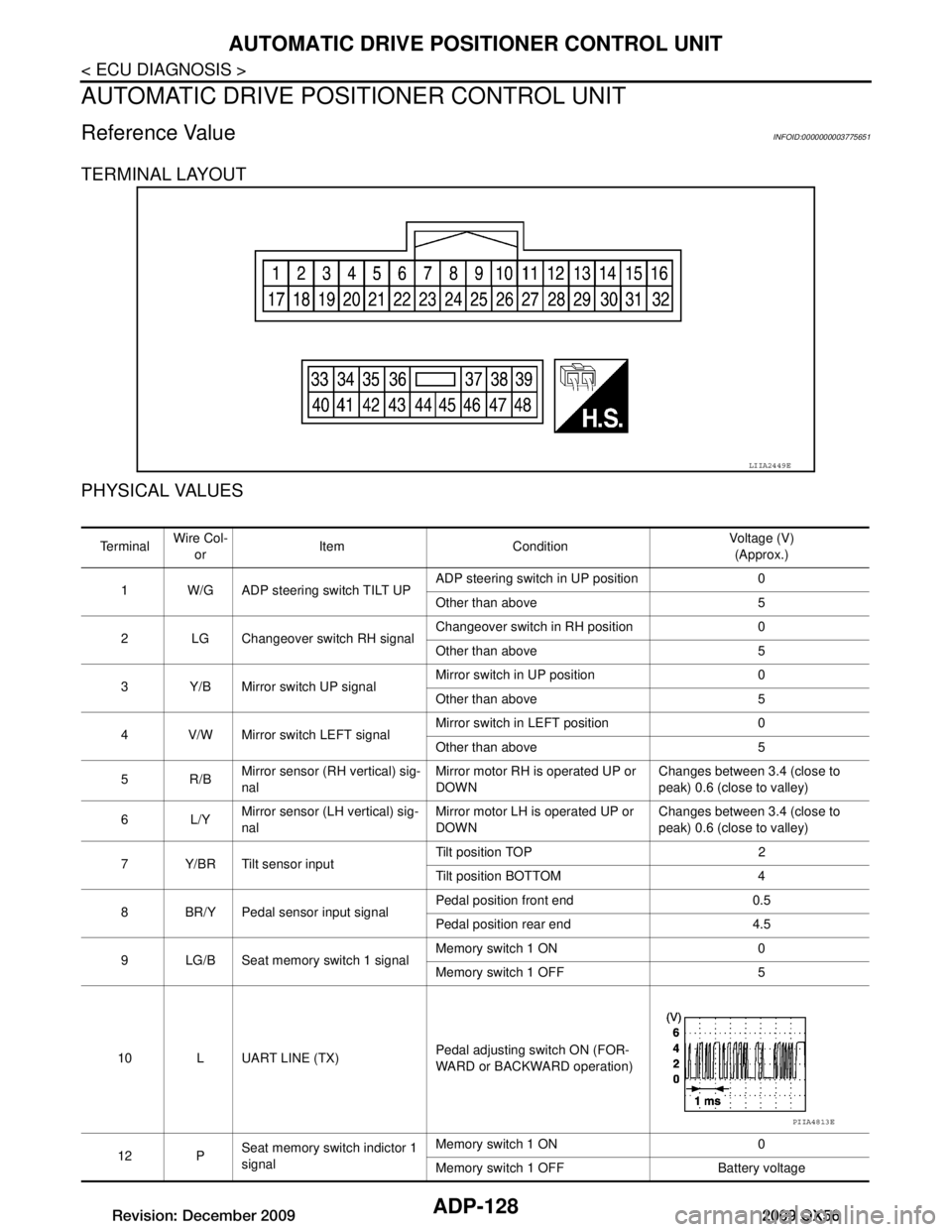
ADP-128
< ECU DIAGNOSIS >
AUTOMATIC DRIVE POSITIONER CONTROL UNIT
AUTOMATIC DRIVE POSITIONER CONTROL UNIT
Reference ValueINFOID:0000000003775651
TERMINAL LAYOUT
PHYSICAL VALUES
LIIA2449E
Te r m i n a l Wire Col-
or Item Condition Voltage (V)
(Approx.)
1 W/G ADP steering switch TILT UP ADP steering switch in UP position 0
Other than above 5
2 LG Changeover switch RH signal Changeover switch in RH position 0
Other than above 5
3 Y/B Mirror switch UP signal Mirror switch in UP position 0
Other than above 5
4 V/W Mirror switch LEFT signal Mirror switch in LEFT position 0
Other than above 5
5R/B Mirror sensor (
RH vertical) sig-
nal Mirror motor RH is operated UP or
DOWN Changes between 3.4 (close to
peak) 0.6 (close to valley)
6L/Y Mirror sensor (L
H vertical) sig-
nal Mirror motor LH is operated UP or
DOWN Changes between 3.4 (close to
peak) 0.6 (close to valley)
7 Y/BR Tilt sensor input Tilt position TOP 2
Tilt position BOTTOM 4
8 BR/Y Pedal sensor input signal Pedal position front end 0.5
Pedal position rear end 4.5
9 LG/B Seat memory switch 1 signal Memory switch 1 ON 0
Memory switch 1 OFF 5
10 L UART LINE (TX) Pedal adjusting switch ON (FOR-
WARD or BACKWARD operation)
12 P Seat memory switch indictor 1
signal Memory switch 1 ON 0
Memory switch 1 OFF Battery voltage
PIIA4813E
Revision: December 20092009 QX56
Page 143 of 4171
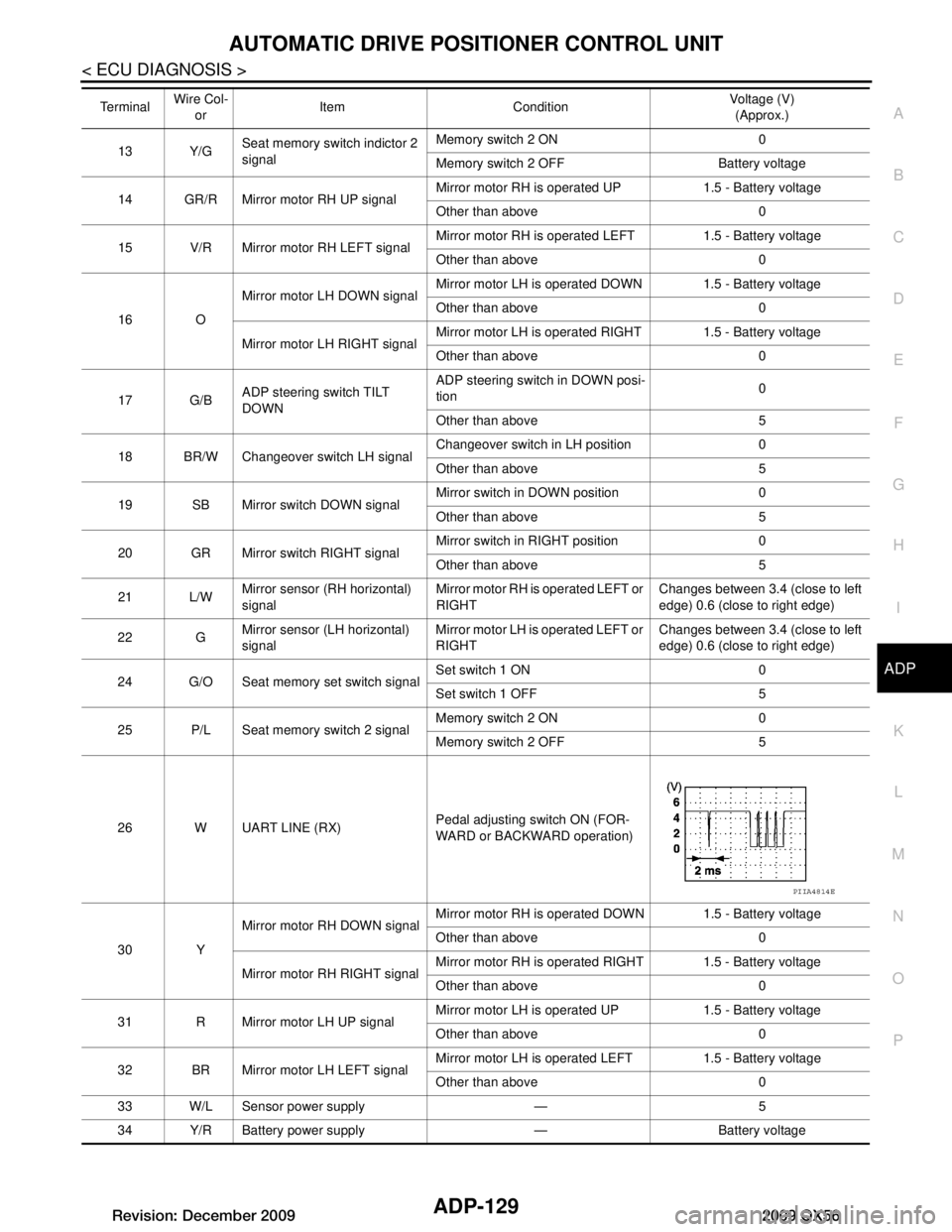
AUTOMATIC DRIVE POSITIONER CONTROL UNITADP-129
< ECU DIAGNOSIS >
C
DE
F
G H
I
K L
M A
B
ADP
N
O P
13 Y/G Seat memory switch indictor 2
signal Memory switch 2 ON 0
Memory switch 2 OFF Battery voltage
14 GR/R Mirror motor RH UP signal Mirror motor RH is operated
UP 1.5 - Battery voltage
Other than above 0
15 V/R Mirror motor RH LEFT signal Mirror motor RH is operated
LEFT 1.5 - Battery voltage
Other than above 0
16 O Mirror motor LH DOWN signal
Mirror motor LH is operated
DOWN 1.5 - Battery voltage
Other than above 0
Mirror motor LH RIGHT signal Mirror motor LH is operated
RIGHT 1.5 - Battery voltage
Other than above 0
17 G/B ADP steering switch TILT
DOWN ADP steering switch in DOWN posi-
tion
0
Other than above 5
18 BR/W Changeover switch LH signal Changeover switch in LH position 0
Other than above 5
19 SB Mirror switch DOWN signal Mirror switch in DOWN position 0
Other than above 5
20 GR Mirror switch RIGHT signal Mirror switch in RIGHT position 0
Other than above 5
21 L/W Mirror sensor (RH horizontal)
signal Mirror motor RH is operated LEFT or
RIGHT Changes between 3.4 (close to left
edge) 0.6 (close to right edge)
22 G Mirror sensor (LH horizontal)
signal Mirror motor LH is operated LEFT or
RIGHT Changes between 3.4 (close to left
edge) 0.6 (close to right edge)
24 G/O Seat memory set switch signal Set switch 1 ON 0
Set switch 1 OFF 5
25 P/L Seat memory switch 2 signal Memory switch 2 ON 0
Memory switch 2 OFF 5
26 W UART LINE (RX) Pedal adjusting switch ON (FOR-
WARD or BACKWARD operation)
30 Y Mirror motor RH DOWN signal
Mirror motor RH is operated
DOWN 1.5 - Battery voltage
Other than above 0
Mirror motor RH RIGHT signal Mirror motor RH is operated
RIGHT 1.5 - Battery voltage
Other than above 0
31 R Mirror motor LH UP signal Mirror motor LH is operated
UP 1.5 - Battery voltage
Other than above 0
32 BR Mirror motor LH LEFT signal Mirror motor LH is operated LEFT 1.5 - Battery voltage
Other than above 0
33 W/L Sensor power supply — 5
34 Y/R Battery power supply — Battery voltage
Te r m i n a l
Wire Col-
or Item Condition Voltage (V)
(Approx.)
PIIA4814E
Revision: December 20092009 QX56
Page 144 of 4171

ADP-130
< ECU DIAGNOSIS >
AUTOMATIC DRIVE POSITIONER CONTROL UNIT
35 R Tilt motor UP signalADP steering switch in UP position Battery voltage
Other than above 0
37 G Pedal adjust motor FORWARD
signal Pedal adjust motor FORWARD op-
eration (Motor operated)
Battery voltage
Other than above 0
39 L/B Battery power supply — Battery voltage
40 B/W Ground — 0
41 W/G Sensor ground — 0
42 V Tilt motor DOWN signal ADP steering switch in DOWN posi-
tion
Battery voltage
Other than above 0
45 R Pedal adjust motor BACK-
WARD signal Pedal adjust motor BACKWARD op-
eration (Motor operated)
Battery voltage
Other than above 0
48 B Ground — 0
Te r m i n a l
Wire Col-
or Item Condition Voltage (V)
(Approx.)
Revision: December 20092009 QX56
Page 163 of 4171

BCM (BODY CONTROL MODULE)ADP-149
< ECU DIAGNOSIS >
C
DE
F
G H
I
K L
M A
B
ADP
N
O P
Te r m i n a l Wire
color Signal name Signal
input/
output Measuring condition
Reference value or waveform
(Approx.)
Ignition
switch Operation or condition
1BR/W Ignition keyhole illumi-
nation Output OFFDoor is locked (SW OFF) Battery voltage
Door is unlocked (SW ON) 0V
2SB Combination switch
input 5 Input ON
Lighting, turn, wiper OFF
Wiper dial position 4
3G/Y Combination switch
input 4 Input ONLighting, turn, wiper OFF
Wiper dial position 4
4Y Combination switch
input 3 Input ON
Lighting, turn, wiper OFF
Wiper dial position 4
5G/B Combination switch
input 2
Input ONLighting, turn, wiper OFF
Wiper dial position 4
6V Combination switch
input 1
9GR/R Rear window defogger
switch
Input ONRear window defogger switch
ON
0V
Rear window defogger switch
OFF 5V
10 G Hazard lamp flash Input OFF ON (opening or closing) 0V
OFF (other than above) Battery voltage
11 O Ignition switch (ACC
or ON)
InputACC or
ON Ignition switch ACC or ON Battery voltage
12 R/L Front door switch RH Input OFF ON (open) 0V
OFF (closed) Battery voltage
13 GR Rear door switch RH Input OFF ON (open) 0V
OFF (closed) Battery voltage
15 L/W Tire pressure warning
check connector
Input OFF — 5V
18 P Remote keyless entry
receiver and optical
sensor (ground)
Output OFF — 0V
SKIA5291E
SKIA5292E
SKIA5291E
SKIA5292E
Revision: December 20092009 QX56
Page 167 of 4171
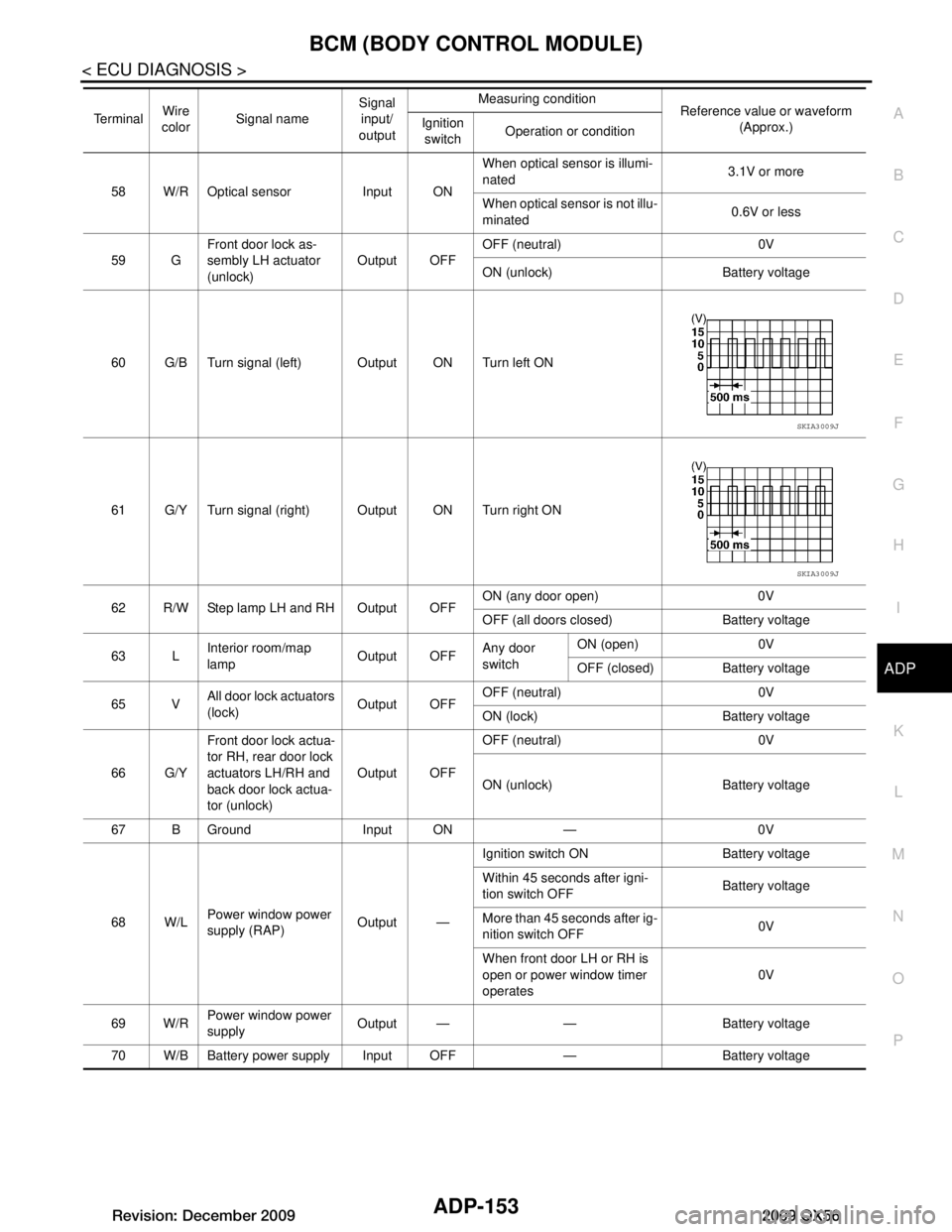
BCM (BODY CONTROL MODULE)ADP-153
< ECU DIAGNOSIS >
C
DE
F
G H
I
K L
M A
B
ADP
N
O P
58 W/R Optical sensor Input ON When optical sensor is illumi-
nated
3.1V or more
When optical sensor is not illu-
minated 0.6V or less
59 G Front door lock as-
sembly LH actuator
(unlock) Output OFF
OFF (neutral) 0V
ON (unlock) Battery voltage
60 G/B Turn signal (left) Output ON Turn left ON
61 G/Y Turn signal (right) Output ON Turn right ON
62 R/W Step lamp LH and RH Output OFF ON (any door open) 0V
OFF (all doors closed) Battery voltage
63 L Interior room/map
lamp Output OFFAny door
switchON (open) 0V
OFF (closed) Battery voltage
65 V All door lock actuators
(lock) Output OFFOFF (neutral) 0V
ON (lock) Battery voltage
66 G/Y Front door lock actua-
tor RH, rear door lock
actuators LH/RH and
back door lock actua-
tor (unlock) Output OFF
OFF (neutral) 0V
ON (unlock) Battery voltage
67 B Ground Input ON — 0V
68 W/L Power window power
supply (RAP) Output —Ignition switch ON Battery voltage
Within 45 seconds after igni-
tion switch OFF
Battery voltage
More than 45 seconds after ig-
nition switch OFF 0V
When front door LH or RH is
open or power window timer
operates 0V
69 W/R Power window power
supply
Output — — Battery voltage
70 W/B Battery power supply Input OFF — Battery voltage
Te r m i n a l
Wire
color Signal name Signal
input/
output Measuring condition
Reference value or waveform
(Approx.)
Ignition
switch Operation or condition
SKIA3009J
SKIA3009J
Revision: December 20092009 QX56
Page 173 of 4171
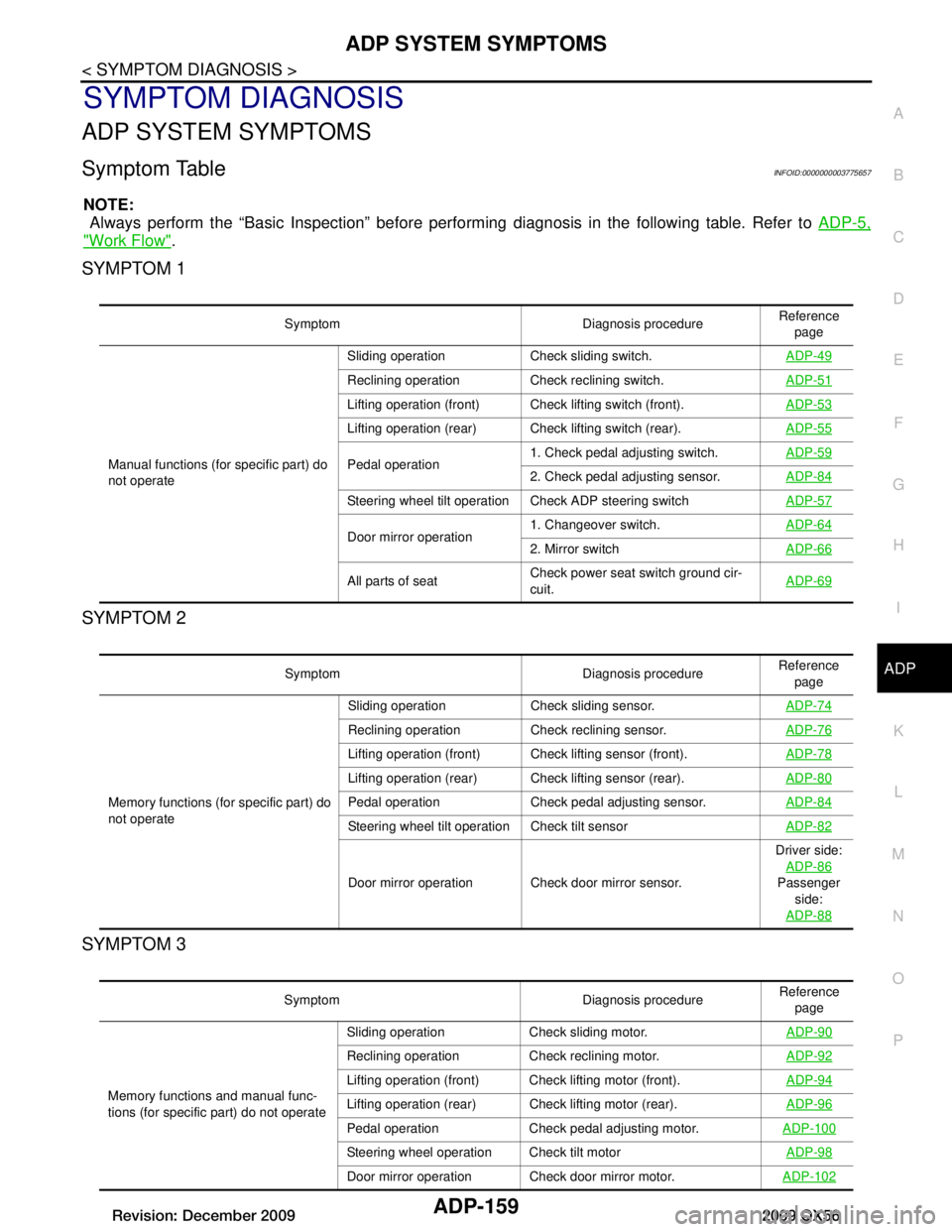
ADP SYSTEM SYMPTOMSADP-159
< SYMPTOM DIAGNOSIS >
C
DE
F
G H
I
K L
M A
B
ADP
N
O P
SYMPTOM DIAGNOSIS
ADP SYSTEM SYMPTOMS
Symptom TableINFOID:0000000003775657
NOTE:
Always perform the “Basic Inspection” before perfo rming diagnosis in the following table. Refer to ADP-5,
"Work Flow".
SYMPTOM 1
SYMPTOM 2
SYMPTOM 3
Symptom Diagnosis procedure Reference
page
Manual functions (for specific part) do
not operate Sliding operation Check sliding switch.
ADP-49
Reclining operation Check reclining switch.ADP-51
Lifting operation (front) Check lifting switch (front).ADP-53
Lifting operation (rear) Check lifting switch (rear).ADP-55
Pedal operation1. Check pedal adjusting switch.
ADP-592. Check pedal adjusting sensor.ADP-84
Steering wheel tilt operation Check ADP steering switch ADP-57
Door mirror operation1. Changeover switch.
ADP-642. Mirror switchADP-66
All parts of seatCheck power seat switch ground cir-
cuit. ADP-69
Symptom Diagnosis procedure Reference
page
Memory functions (for specific part) do
not operate Sliding operation Check sliding sensor.
ADP-74
Reclining operation Check reclining sensor.ADP-76
Lifting operation (front) Check lifting sensor (front).ADP-78
Lifting operation (rear) Check lifting sensor (rear).ADP-80
Pedal operation Check pedal adjusting sensor.ADP-84
Steering wheel tilt operation Check tilt sensorADP-82
Door mirror operation Check door mirror sensor. Driver side:
ADP-86Passenger side:
ADP-88
Symptom Diagnosis procedure Reference
page
Memory functions and manual func-
tions (for specific part) do not operate Sliding operation Check sliding motor.
ADP-90
Reclining operation Check reclining motor.ADP-92
Lifting operation (front) Check lifting motor (front).ADP-94
Lifting operation (rear) Check lifting motor (rear).ADP-96
Pedal operation Check pedal adjusting motor.ADP-100
Steering wheel operation Check tilt motor ADP-98
Door mirror operation Check door mirror motor.ADP-102
Revision: December 20092009 QX56
Page 176 of 4171

ADP-162
< PRECAUTION >
PRECAUTIONS
PRECAUTION
PRECAUTIONS
Precaution for Supplemental Restraint System (SRS) "AIR BAG" and "SEAT BELT
PRE-TENSIONER"
INFOID:0000000005848468
The Supplemental Restraint System such as “A IR BAG” and “SEAT BELT PRE-TENSIONER”, used along
with a front seat belt, helps to reduce the risk or severi ty of injury to the driver and front passenger for certain
types of collision. This system includes seat belt switch inputs and dual stage front air bag modules. The SRS
system uses the seat belt switches to determine the front air bag deployment, and may only deploy one front
air bag, depending on the severity of a collision and w hether the front occupants are belted or unbelted.
Information necessary to service the system safely is included in the SR and SB section of this Service Man-
ual.
WARNING:
• To avoid rendering the SRS inopera tive, which could increase the risk of personal injury or death in
the event of a collision which would result in air bag inflation, all maintenance must be performed by
an authorized NISS AN/INFINITI dealer.
Improper maintenance, including in correct removal and installation of the SRS, can lead to personal
injury caused by unintent ional activation of the system. For re moval of Spiral Cable and Air Bag
Module, see the SR section.
Do not use electrical test equipmen t on any circuit related to the SRS unless instructed to in this
Service Manual. SRS wiring harnesses can be identi fied by yellow and/or orange harnesses or har-
ness connectors.
PRECAUTIONS WHEN USING POWER TOOLS (AIR OR ELECTRIC) AND HAMMERS
WARNING:
When working near the Airbag Diagnosis Sensor Unit or other Airbag System sensors with the Igni-
tion ON or engine running, DO NOT use air or electri c power tools or strike near the sensor(s) with a
hammer. Heavy vibration could activate the sensor( s) and deploy the air bag(s), possibly causing
serious injury.
When using air or electric power tools or hammers , always switch the Ignition OFF, disconnect the
battery, and wait at least 3 minu tes before performing any service.
Precaution Necessary for Steering W heel Rotation After Battery Disconnect
INFOID:0000000005851835
NOTE:
This Procedure is applied only to models with Intelli gent Key system and NATS (NISSAN ANTI-THEFT SYS-
TEM).
Remove and install all control units after disconnecting both battery cables with the ignition knob in the
″LOCK ″ position.
Always use CONSULT-III to perform self-diagnosis as a part of each function inspection after finishing work.
If DTC is detected, perform trouble diagnosis according to self-diagnostic results.
For models equipped with the Intelligent Key system and NATS, an electrically controlled steering lock mech-
anism is adopted on the key cylinder.
For this reason, if the battery is disconnected or if the battery is discharged, the steering wheel will lock and
steering wheel rotation will become impossible.
If steering wheel rotation is required when battery pow er is interrupted, follow the procedure below before
starting the repair operation.
OPERATION PROCEDURE
1. Connect both battery cables. NOTE:
Supply power using jumper cables if battery is discharged.
2. Use the Intelligent Key or mechanical key to turn the ignition switch to the ″ACC ″ position. At this time, the
steering lock will be released.
3. Disconnect both battery cables. The steering lock will remain released and the steering wheel can be
rotated.
4. Perform the necessary repair operation.
Revision: December 20092009 QX56
Page 199 of 4171
![INFINITI QX56 2009 Factory Workshop Manual AV
NAVIGATION SYSTEMAV-13
< FUNCTION DIAGNOSIS > [AUDIO SYSTEM]
C
D
E
F
G H
I
J
K L
M B A
O P
NAVIGATION SYSTEM
System DiagramINFOID:0000000003776772
System DescriptionINFOID:0000000003776773
NOTE:
Re INFINITI QX56 2009 Factory Workshop Manual AV
NAVIGATION SYSTEMAV-13
< FUNCTION DIAGNOSIS > [AUDIO SYSTEM]
C
D
E
F
G H
I
J
K L
M B A
O P
NAVIGATION SYSTEM
System DiagramINFOID:0000000003776772
System DescriptionINFOID:0000000003776773
NOTE:
Re](/img/42/57031/w960_57031-198.png)
AV
NAVIGATION SYSTEMAV-13
< FUNCTION DIAGNOSIS > [AUDIO SYSTEM]
C
D
E
F
G H
I
J
K L
M B A
O P
NAVIGATION SYSTEM
System DiagramINFOID:0000000003776772
System DescriptionINFOID:0000000003776773
NOTE:
Refer to NAVI System Owner's Manual for system operation.
The navigation system periodically calculates the vehicl e's current position according to the following three
signals: Travel distance of the vehicle as determined by the vehicle speed sensor, turning angle of the vehicle
as determined by the gyroscope (angular velocity sensor), and the direction of vehicle travel as determined by
the GPS antenna (GPS information).
The current position of the vehicle is then identified by comparing the calculated vehicle position with map data
read from the map data, which is stored in the har d disk drive (HDD)(map-matching), and indicated on the
screen with a current-location mark.
By comparing the vehicle position detection results found by the
GPS and by map-matching, more accurate vehicle position data can
be used.
The current vehicle position will be calculated by detecting the dis-
tance the vehicle moved from the previous calculation point and its
direction.
TRAVEL DISTANCE
Travel distance calculations are based on the vehicle speed input signal. Therefore, the calculation may
become incorrect as the tires wear down. To prevent this, an automatic distance fine adjustment function has
been adopted.
TRAVEL DIRECTION
Change in the travel direction of the vehicle is calculated by a gyroscope (angular velocity sensor) and a GPS
antenna (GPS information). As the gyroscope and GP S antenna have both merit and demerit, input signals
from them are prioritized in each situation. However, this order of priority may change in accordance with more
detailed travel conditions so that the travel direction is detected more accurately.
ALNIA0424GB
SEL684V
Revision: December 20092009 QX56
Page 200 of 4171
![INFINITI QX56 2009 Factory Workshop Manual AV-14
< FUNCTION DIAGNOSIS >[AUDIO SYSTEM]
NAVIGATION SYSTEM
MAP–MATCHING
Map–matching is a function that repositions the vehicle on the road
map when a new location is judged to be the most accur INFINITI QX56 2009 Factory Workshop Manual AV-14
< FUNCTION DIAGNOSIS >[AUDIO SYSTEM]
NAVIGATION SYSTEM
MAP–MATCHING
Map–matching is a function that repositions the vehicle on the road
map when a new location is judged to be the most accur](/img/42/57031/w960_57031-199.png)
AV-14
< FUNCTION DIAGNOSIS >[AUDIO SYSTEM]
NAVIGATION SYSTEM
MAP–MATCHING
Map–matching is a function that repositions the vehicle on the road
map when a new location is judged to be the most accurate. This is
done by comparing the current vehicle position, calculated by the
method described in the position detection principle, with the road
map data around the vehicle, read from the map data stored on the
HDD.
Therefore, the vehicle position may not be corrected after the vehicle
is driven over a certain distance or time in which GPS information is
hard to receive. In this case, the current-location mark on the display
must be corrected manually.
CAUTION:
The road map data is based on data stored on the HDD.
• In map-matching, alternative rout
es to reach the destination will be
shown and prioritized, after the road on which the vehicle is cur-
rently driven has been judged and the current-location mark has
been repositioned.
If there is an error in distance and/or direction, the alternative
routes will be shown in different order of priority, and the wrong
road can be avoided.
If two roads are running in parallel, they are of the same priority.
Therefore, the current-location mark may appear on either of them
alternately, depending on maneuvering of the steering wheel and
configuration of the road.
• Map-matching does not function correctly when the road on which the vehicle is driving is new and not recorded on the HDD, or when
the road pattern stored in the m ap data and the actual road pattern
are different due to repair.
When driving on a road not present in the map, the map-matching
function may find another road and position the current-location
mark on it. Then, when the correct road is detected, the current-
location mark may leap to it.
• Effective range for comparing the vehicle position and travel direc-
tion calculated by the distance and direction with the road data
read from the HDD is limited. Therefore, when there is an exces-
sive gap between the current vehicle position and the position on
the map, correction by map-matching is not possible.
GPS (GLOBAL POSITIONING SYSTEM)
GPS (Global Positioning System) has been developed and con-
trolled by the US Department of Defense. The system utilizes GPS
satellite (NAVSTAR), sending out radio waves while flying on an orbit
around the earth at the height of approx. 21,000 km (13,000 miles).
The GPS receiver calculates the vehicle's position in three dimen-
sions (latitude/longitude/altitude) according to the time lag of the
radio waves received from four or more GPS satellites (three-dimen-
sional positioning). If radio waves were received only from three
GPS satellites, the GPS receiver calculates the vehicle's position in
two dimensions (latitude/longitude), utilizing the altitude data calcu-
lated previously by using radio wa ves from four or more GPS satel-
lites (two-dimensional positioning).
Type Advantage Disadvantage
Gyroscope (angular velocity sensor) • Can detect the vehicle's turning angle quite
accurately. • Direction errors may accumulate when the ve-
hicle is driven for long distances without stop-
ping.
GPS antenna (GPS information) • Can detect the vehicle's travel direction
(North/South/East/West). • Correct direction cannot be detected when the
vehicle speed is low.
SEL685V
SEL686V
ALNIA0839GB
SEL526V
Revision: December 20092009 QX56